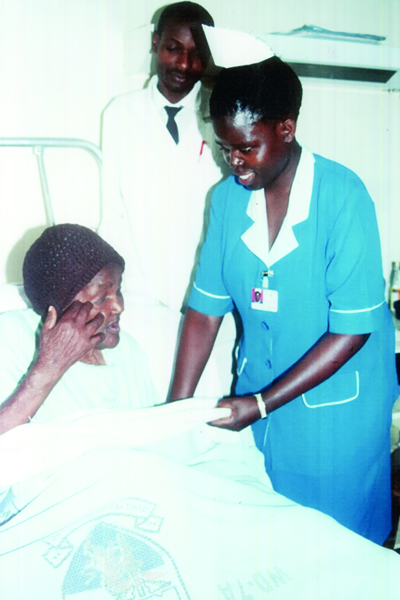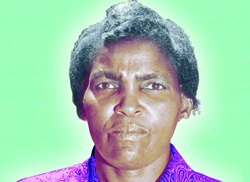
Sarah Sarai Jommo achieved many firsts in her lifetime. She was the first African woman allowed to perform nursing duties at the Aga Khan Hospital, which was then a clinic. She was also the first African woman to serve on the Nairobi African Advisory Council from 1949-1951. She was also the longest serving Kenyan woman detainee in the fight for Kenya’s freedom from the British colonialists, having been arrested on October 20, 1952 for her role in the Mau Mau armed rebellion.
The name Sarah Sarai might not quickly ring a bell but, like many unsung heroes and heroines, she lived an extraordinary life, making an indelible mark both in the medical field and in Kenya’s history. Sarai fought racial segregation at a personal level. She bought herself a bicycle to avoid riding in segregated commuter buses. In the early 1960s, she was simply known as Mama Uhuru (Mother of Freedom).The next decade and up to the mid-1970s would mark her talk show-host years. Families would jostle for space around the family transistor radio to listen to the delightful voice of the ‘Children’s Auntie’ or Tata wa Ciana issuing a new episode, a story, or lessons for women. The subjects covered self, home and family management. She would sign off, “It’s your auntie, Sarah Sarai!” Accounts from her diaries, an unpublished autobiography and testimonies from former detainees and political activists indicate that Sarah Sara was born Thara on November 3, 1913, in Kinoo, Kiambu. She was the fourth child of Jommo wa Gichanga and his part-Maasai first wife Bellewa.
From a polygamous family, Sarah had six mothers and more than 20 siblings. Defiance and trailblazing marked her life–literally–from birth when she eluded death. Her mother had had so many miscarriages and stillbirths that this particular baby girl was ritually snatched from death’s jaws–hence the name Thara – the resilient Napier grass). She was christened Sarah by the Rev Dr John William Arthur to crystallise her defiance of tradition in pursuit of Christianity and education. From the tender age of five, Sarai was attracted to the goings-on at a nearby Church of Scotland Mission (CSM) in Thogoto. She engaged her traditionalist father in a cat-and-mouse game, running away to the CSM School. She was pursued, abducted and brought back home, only to escape again. In 1926, patriarch Jommo moved his family from the overcrowded Kabete-Kinoo-Kikuyu area – the result of land-grabbing by colonial institutions, missionaries and settlers – to Njoro in the Rift Valley.
There, Sarai was forced to undergo circumcision. Upon healing, the barely 13-year-old girl escaped with her step-sister Wanyoro, stowed away in a goods train, back to school in Thogoto. Her father relented but disowned her. Meanwhile, back in Njoro, a near exodus played out. One Capt. Graham – in whose farm Sarai’s siblings worked – lost his free child labourers. Sarai’s siblings, impressed with her newly acquired English – how she would break into ‘moni-moni’ (good-morning) and ‘yes’, ‘no’ conversations with the settler’s family – all followed Sarai to school.
On completing school under the tutelage of Reverends Musa Gitau and Jackson Njiraine, Sarai trained as a nurse and midwife under Minnie Watson and Rev Dr Arthur. While still in training, she joined Rev.Dr. Arthur’s well-documented crusades against female circumcision, traversing the ridges from Kiambu to Fort Hall (Murang’a) to Tumu Tumu in Nyeri. They walked, entering homesteads where they were inevitably received with hostility, but they laboured on.
Kikuyu morans riposted by ritually blacklisting her in their Mũthĩrĩgũ dance counter-crusades of 1929, which led to a big walkout by new converts to form their own Karing’a (African Independent Orthodox Church). But Sarai and her mentor had the satisfaction of seeing the cut increasingly rejected among the remaining converts. At a time when African women did not venture beyond their villages, Sarai was part of a small coterie of African professionals who broke out. From the mid-1930s to the early 1940s, she worked in hospitals in far-flung corners of East Africa – Fort Hall (Murang’a), Msambweni (South Coast), Coast General Hospital in Mombasa, Kilifi, Tanga in Tanganyika, and Mulago in Kampala. As a designated health visitor, she visited families and taught them hygiene, discouraging women from traditional practices that affected their reproductive health and esteem. She moved to Nairobi in 1942, where she was the first African woman nurse at The Aga Khan Hospital, then a clinic. She later worked as a theatre nurse at the European Base Hospital, located in today’s State House Girls’ High School. Despite her career growth, she was designated and paid as a subordinate staff.
After World War II, Sarai joined the Municipal Council of Nairobi as a Social Welfare Assistant, initiating social and child welfare programmes in the African residential areas of Eastlands. She was the first African woman to serve on the Nairobi African Advisory Council from 1949 to 1951. She also fought for women’s employment and maternity leave, as well as the relocation of families, arguing that discouraging families from relocating was equal to denial of conjugal rights. She took up this cause as she believed it could help prevent sexually transmitted infections (STIs), which male workers passed on to their rural-based wives when they joined them while on leave. Sarai fought racial segregation at a personal level. She bought herself a bicycle to avoid riding in segregated commuter buses where Europeans took upholstered seats upfront while Africans sat on wooden seats at the back.
As a breastfeeding mother, she would take her baby’s wicker basket to her office at Social Hall Pumwani, against all regulations, thus making a statement about maternity and early childhood rights. The epitome of Western-style elegance, Sarai defied the double standards of missionaries and church elders at Thogoto, where African women were not allowed to grow hair or wear shoes. She set fashion standards for upwardly-mobile African women. When Princess (now Queen) Elizabeth landed at Eastleigh Airport in 1951, she presented her with a floral bouquet to which she attached a memorandum detailing African grievances. Shut out from the exclusively European East African Women’s League, Sarai formed the Nairobi African Women’s League (NAWL), intending to overwhelm the Europeans with the sheer numbers of the ‘real African’ league, such that a merger would be inevitable. NAWL membership straddled class and ethno-cultural/religious divisions of the day. The idea was to extract more political space for African women, and to support women leaders to respond to the needs and interests of their own. The Asian Women’s Association welcomed NAWL, a development that must have alarmed the colonial masters.

Faced with colonial intransigence, Sarai joined Kenya African Union (KAU), which was mobilising political pressure to end colonial rule. Sarai (NAWL secretary-general) and Rebeka Njeri (president) were the only two women arrested alongside the KAU leadership on October 20, 1952. The governor ordered her jailed for eight years. Under torture, Sarai refused to obtain freedom through confession of the Mau Mau oath. Kamiti Prison authorities then turned around and enlisted her services at the prison dispensary. Sarai was thus spared from the backbreaking labour in quarries and digging of trenches in which prisoners buried dead fighters and villagers brought in trucks from the forests and villages. Sarai spent her evenings trauma-counselling other prisoners and praying with them in whispers.
Sarai taught fellow prisoners about personal hygiene, treated the warders for STIs, gave literacy classes, preached, politicked, and wrote letters, which were smuggled out to families. One of her colleagues and students at Kamiti was Mama Ngina Kenyatta, for whom she drafted letters destined for her husband, Jomo Kenyatta, who was to be Kenya’s first president and founding father of independent Kenya. Jomo Kenyatta was incarcerated in Lodwar. The nurse-cum-freedom fighter would fire off petitions and memoranda to the governor, the British prime minister and even the queen of England, which probably never got past the prison gates. She got no acknowledgement or response, but never tired or despaired sufficiently to buy her freedom through ‘confession’. She was finally accorded a room where she taught knitting, embroidery, sewing, and making handicrafts such as handbags and knapsacks. Sarai was freed at the end of 1959, but was on a one-year restriction in her birth place; Kinoo. Upon her release, the longest-serving female political prisoner of the Mau Mau era immersed herself in the groundswell of multi-party pre-independence politics, a lone woman among the political giants of the day. She was elected to the Governing Council of KANU Women’s Wing in June 1962.
She was also recruited into the Moral Re-Armament (MRA) – an American counter-communism initiative. As independence dawned, the white settler leadership was working feverishly to forestall the possibility of an alignment with the East by an incoming black leadership, embittered by years of incarceration. Col Alan Knight – a former prison superintendent-turned-MRA-disciple – led the settler team that invited Sarai deep into the White Highlands at Narrosura Farm near Rongai, for MRA conventions themed on love, honesty and forgiveness. She was subsequently invited to Caux-sur- Montreux in the Swiss Alps. Sarai was ready to explore other systems. She embraced the MRA doctrine with the same fervour as she had Christianity. She visited Eastern Europe, USSR and China and was able to observe the socialist model at work – especially those aspects related to social and gender justice. She used discourse to pursue social justice for the rights of women in Kenya. A letter written to her by Eva Maríková, Editor-in-Chief of the journal Czechoslovak Woman in 1964 encouraged her saying: “I wish all the women in Kenya ‘soon reach the summit of the mountain at the foot of which they are now standing’ – as you expressed so poetically, beautifully and very correctly in the discussion…”
Sarai was a larger-than-life nationalist and pan-Africanist whose activism transcended gender, race-tribal/ethnic, class and even national boundaries. A believer in non-violence, she participated in campaigns to prevent the Shifta war, persuading Somalia to expunge its expansionist ideology. On a visit to Ethiopia in September 1963, she was received by Emperor Haile Selassie, from whom she obtained permission to organise a massive demonstration in Addis Ababa against Somalia’s claim to north-eastern Kenya and Ethiopia’s Ogaden region. Photographs show a lone woman, in the company of one or two other Kenyans, leading thousands of predominantly male Ethiopian demonstrators. During the student airlifts of the 1960s, she cut short a trip to China because of Kenyan students
stranded in Cairo, Egypt. She led them to various embassies until all obtained scholarships to proceed for further studies in various destinations, including Sweden, the USSR and USA.
The post-colonial dispensation sidelined Sarai. Undaunted, she joined other nationalists to form the Kirinyaga Welfare Association, which sought to rehabilitate and reconcile families torn apart by the State of Emergency, helping former detainees to regain dignity and engage in the search for national social cohesion. Although the association was frustrated out of existence, Sarai went on to initiate her famous radio programme, Tata wa Ciana aired in Voice of Kenya’s vernacular service.
Arthritis and Alzheimer’s disease took a toll on her physical and mental health and she breathed her last on Monday, July 14, 2003.
